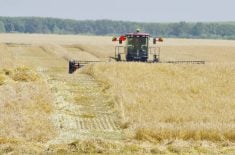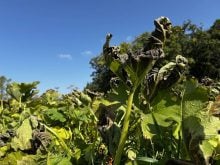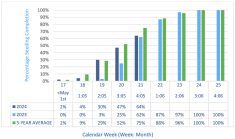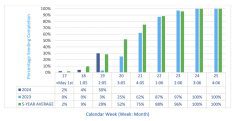Winter wheat and fall rye harvest is underway in Central Manitoba. Grass seed harvest has begun in Central Manitoba and the Interlake.
Many regions in the province are below normal precipitation and would benefit from rain. Most of the Southwest and Northwest received less than 5 mm of rain over the past week. Heat unit accumulation is generally near normal.
The majority of spring seeded crops have finished flowering and are in the podding and grain-filling stage.
Haying continues throughout the province. Hayland and pastures are showing signs of moisture stress in dry regions.
Read Also

Province pledges funds to CentrePort Canada
The Manitoba government has pledged $450,000 towards projects at inland port CentrePort Canada.
Southwest Region
Temperatures were warmer than normal for much of the week. In most of the region rainfall ranged from 0 to 5 mm, but upwards of 20 mm fell in the Mountainside and Ninette areas. Most of the region could use moisture, and many crops have lost potential yield due to the dry conditions.
Winter wheat and fall rye are getting close to harvest. Pre-harvest applications continue to be made this week with harvest to follow shortly if warm temperatures continue.
Peas are starting to turn and the hot weather has caused some of the top pods to ripen prematurely. Overall crop looks to be in good to excellent condition.
Cereal crops are showing the effects of the heat and dry weather. Several fields are starting to ripen prematurely. Fusarium head blight levels are very low this year. There are some reports of aphids and army worms in spring wheat but they have not reached economic threshold levels.
In canola, 90 per cent of the fields have finished flowering. There has been some flower abortion in canola due to the high temperatures during flowering.
Corn and sunflower crops are developing well in the warm weather. Approximately 60 per cent of sunflower crops are heading and the remaining are at the R4 stage. Corn is tasseling.
Warmer conditions are benefiting the soybean crops. Most fields range from the R3 to R4 stage. Some fields are showing the signs of moisture stress.
Thistle caterpillar numbers continue to be monitored on soybeans, no control measures have been applied at this time. Bertha armyworm counts are dropping and remain in the low risk range. Diamond back moth larvae have been found in elevated numbers around Brandon, Hartney, and some Western areas. Monitoring continues and insecticides have been applied to some fields.
Pastures, dugouts and sloughs are beginning to suffer from the hot, dry weather. Early alfalfa hay cuts have allowed for good regrowth and a possible second cut. Most first cut hay is complete with yields ranging from average to above average; quality is good.
Northwest Region
The Northwest Region had high temperatures through the week and while crops are advancing, the effects of heat stress are showing up. The hot weather brought thunderstorms over the weekend with precipitation amounts ranging from 5 to 20 mm across the Swan Valley, 17 mm around The Pas, and trace amounts through the Dauphin and Roblin areas. Some hail and high winds were reported southwest of Roblin and through Minitonas but damage has not yet been determined. Soil moisture conditions within the Northwest Region range from adequate at The Pas to dry through Roblin, Swan River and parts of the Dauphin area.
Crops are advancing quickly through the region, although the high temperatures along with higher night time temperatures are expected to negatively affect yield potential. Crop condition ranges from good where adequate soil moisture exists to fair in drier parts of the region. The majority of the spring wheat crop is heading and entering into the milk/dough stage. Some early seeded spring wheat fields are turning. Except for later seeded canola fields which are in full flower, most canola has finished flowering with approximately 40 to 80 per cent podded. In dry areas of the region, aborted pods are showing up. Flax is in full flower and peas are in the podding stage. Soybeans and lentils are flowering and podding. Winter cereals are ripening but harvest has not yet begun. Bertha armyworm larvae levels are declining, but weekly trap count numbers in the Durban and Benito areas are at the uncertain risk level. Numbers remain low for diamondback moth larvae.
Although most of the region would benefit from some rain, this past week’s ideal haying weather allowed producers to wrap up harvesting of first cut tame forages. Native hay harvest is ongoing with average to above average yields. Grass seed residues such as perennial ryegrass are being baled for feed. Greenfeed harvest has begun with some fields cut in the Swan River area.
Second cut alfalfa harvest for beef operations has not begun but yields are expected to be below average due to lower moisture conditions. Corn silage crops are tasseling in the Roblin area with the rest of the region further behind in development. Moisture will be needed to fill the cobs.
Pastures are holding steady in most areas, but beginning to show signs of low moisture and high heat stress. There are reports of livestock watering dugouts getting low near the Assiniboine River Valley area.
Central Region
Rapid crop growth and advancement has been seen with warmer than normal temperature and high humidity. Rain and thundershowers were extremely variable throughout the region. Clearwater had the most rainfall with 42 mm, but most of the region had less than 5 mm. Some lodging remains in cereal crops from storms last week. Some crops are ripening prematurely due to lack of rain, especially in areas with gravel and sand ridges, and areas with salinity. Rain is needed for grain fill in much of the later maturing crop, especially corn and soybeans.
There are scattered reports of hot spots of insect activity and disease presence in crops; but incidence is generally low.
Forage seed crops are being swathed, and harvest has started. Stands look good, and average to above average yields are expected.
The majority of cereals are growing well. Harvest has begun in fall rye and winter wheat; no yield reports to date.
Staging for pre-harvest applications in cereals has started. Most spring wheat, barley and oats are in the late milk stage to soft dough stage. Little to no evidence of fusarium head blight symptoms in winter wheat or earlier seed spring wheat reported to date. There is some evidence of cereal leaf beetle. Some spraying of aphids on wheat has occurred in western areas due to elevated populations.
Canola fields range from late flower, to full pod and the start of seed colour change. Mid-late planted canola is suffering from heat and lack of moisture; some heat blasting is evident.
Bertha armyworm numbers remain relatively low for most of the region. Some spraying for diamondback moth has been done in hot spots, especially in areas that have not received much rainfall. Some lygus activity has been noted.
The majority of corn fields have tasseled and silking is evident. Flowering is complete in peas, pod fill is good, and some fields are starting to turn. Most flax fields are in full boll, with some turning. Some fields have started to flower again after recent rains.
Soybeans are flowering; earliest seeded fields are in the R3 to R5 stage, with good podding evident. Rhizoctonia, fusarium root rot, pythium, and phytophthera have been confirmed in soybean fields. Soybean aphids have been found in some fields, and some spraying has occurred. White mould is noted in a few fields.
Edible beans are flowering, and pods are evident; staging ranges from R3-R4. Fungicide applications are taking place in fields where canopy closure is imminent and moisture conditions are conducive to disease development.
Sunflowers are in R4 to R5.4. Some basal stalk rot is starting to show up. Scouting and staging continues for head insects and disease presence. Insecticide applications are being made for lygus control.
Thistle caterpillar continues to be monitored in soybean and sunflower; damaging stage is generally finished.
Grasshoppers are being found in fields, especially in drier areas. Monitoring continues, and some control measures have been taken where crop injury warrants.
Good haying progress has been made due to the hot and windy weather. Pasture and hay growth improved with the heat. Areas that have received adequate rainfall in the Western and Northwestern parts of the region report excellent regrowth, but some areas are quite dry. Yields are average to below average. Second cut dairy quality hay continues in areas of early first cut and where conditions allow, and will continue over the next two to three weeks. Some Western and Southwestern areas will not have a second cut of beef quality hay due to the dry conditions. Pastures are dry and turning brown. Rain is needed if pastures are going to take livestock into the fall. Good quality hay is available.
Livestock water supply is adequate.
Eastern Region
Rainfall accumulation varied with 10 to 15 mm of rain in central and northern districts while only isolated showers with minimal accumulations occurred in southern districts. Warm season crops advanced rapidly with the warm weather. Soil moisture conditions on cropland across the region and are rated as 10 per cent surplus, 80 per cent adequate and 10 per cent short. Soil moisture conditions on hay and pasture land are rated at 60 per cent adequate, 20 per cent short and 20 per cent very short. The driest soil conditions are in the southern districts.
Scouting continues for insects, very few insecticides have been applied.
Spring wheat is at the soft dough stage. Corn is at the tassel stage. Canola is in the pod filling stage with only late seeded or reseeded canola still flowering. Canola condition remains good to excellent. Low levels of diamondback moths have been detected on many fields but no reports of spraying have been received so far. Soybeans are at the R3 stage. While overall foliar and stem disease levels remain low, there are some fields where root rots and/or stem diseases caused moderate to severe stand losses. Soybean aphids have been detected in many fields, and numbers of aphids and aphid predator insects continue to increase. No reports of insecticide applications have been received. Green cloverworm and grasshopper feeding activity have been reported but defoliation levels were still very low. Sunflowers are at early R5. Low disease and insect pest levels have been detected so far.
Haying continues with producers putting up about three quarters of feed requirements.
Livestock pastures are starting to dry up. There have been reports of armyworms feeding on the lush grass in hayfields. The progress of the first cut of hay is estimated at 20 per cent standing, 5 per cent cut, and 75 per cent baled/silaged. Second cut alfalfa hay is estimated at 1.5 tonnes/acre with grass/alfalfa hay at 1.25 tonnes/acre. Hay quality is rated as good. Hay field condition is rated at 80 per cent good and 20 per cent fair. Pasture conditions is rated at 60 per cent good, 20 per cent fair and 20 per cent poor condition. Availability of livestock water is rated as adequate.
Interlake Region
Temperatures soared to as high as 32ºC this past week, causing some abortions of canola flowers on later seeded crops. Crops are advancing quickly with the heat. Corn heat units and growing degree days are near normal for the region; however, the percentage of normal accumulated precipitation since May 1 varies from 64 per cent at Eriksdale to 100 per cent at Fisherton. Rainfall throughout the region varied from 0 to 8.7 mm in the last week.
Fungicide applications on canola and wheat are nearing completion, however spraying on some late seeded crops is still in process. Canola in many south Interlake fields has entered pod stage while most canola in the north Interlake is still at late flowering stage. In early seeded canola the seeds are green but firm.
Soybeans are mostly in late flowering to early pod development stage (R2-R3). Soybeans are being closely monitored for aphids. Some aphids are showing up in fields in the south Interlake, little yet in north Interlake.
Corn in south Interlake is at the early tassel stage. Flax is mostly finished flowering, and peas have started podding. Sunflowers are at 50 to 60 per cent bloom stage.
Spring wheat is fully headed out; barley is starting to ripen. Some tall fescue and meadow fescue grass seed crops are being combined and yields are in the 600 to 650 lb/acre range. Timothy seed harvest will start soon. Some alfalfa seed crops have aphids and lygus bugs and are being sprayed for the second or third time with insecticides.
Winter wheat and fall rye are starting to ripen and are showing very low incidence of ergot. Some pre-harvest applications will be occurring later in the week, weather permitting.
Haying continues. Grasshoppers started to show up in roadsides, pastures, and hay fields at low levels, but with little damage so far. Second growth of alfalfa hay is quite good and is minimally affected by alfalfa weevil larvae damage. Native and grass hay growth is stalling with recent heat. Pastures are in good to fair condition with some rotation of cattle onto ungrazed pastures. There is adequate water for livestock consumption.














